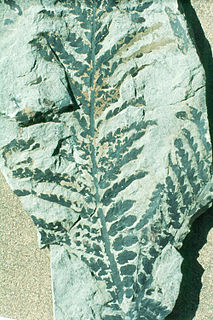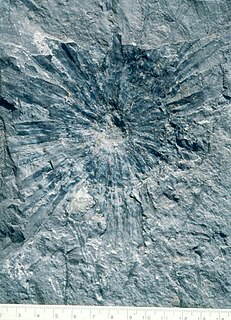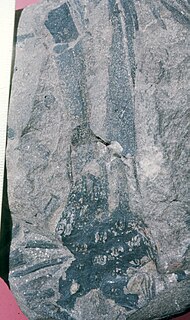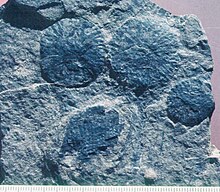The Triassic is a geologic period and system which spans 50.6 million years from the end of the Permian Period 251.902 million years ago (Mya), to the beginning of the Jurassic Period 201.36 Mya. The Triassic is the first and shortest period of the Mesozoic Era. Both the start and end of the period are marked by major extinction events. The Triassic Period is subdivided into three epochs: Early Triassic, Middle Triassic and Late Triassic.

Dickinsonia is an extinct genus of basal animal that lived during the late Ediacaran period in what is now Australia, China, India, Russia and Ukraine. The individual Dickinsonia typically resembles a bilaterally symmetrical ribbed oval. Its affinities are presently unknown; its mode of growth is consistent with a stem-group bilaterian affinity, though some have suggested that it belongs to the fungi, or even an "extinct kingdom". The discovery of cholesterol molecules in fossils of Dickinsonia lends support to the idea that Dickinsonia was an animal.

Isoetales, sometimes also written Isoëtales, is an order of plants in the class Lycopodiopsida.

The Early Triassic is the first of three epochs of the Triassic Period of the geologic timescale. It spans the time between 251.902 Ma and 247.2 Ma. Rocks from this epoch are collectively known as the Lower Triassic Series, which is a unit in chronostratigraphy.

In the geologic timescale, the Olenekian is an age in the Early Triassic epoch; in chronostratigraphy, it is a stage in the Lower Triassic series. It spans the time between 251.2 Ma and 247.2 Ma. The Olenekian is sometimes divided into the Smithian and the Spathian subages or substages. The Olenekian follows the Induan and is followed by the Anisian.

Shonisaurus is a very large genus of ichthyosaur. At least 37 incomplete fossil specimens of the marine reptile have been found in the Luning Formation of Nevada, USA. This formation dates to the late Carnian age of the late Triassic period, about 237–227 million years ago.
Pleuromeia is an extinct genus of lycophytes. They are related to modern quillworts (Isoetes). Pleuromeia dominated vegetation during the Early Triassic all over Eurasia and elsewhere, in the aftermath of the collapse of floral communities during the Permian–Triassic extinction event, often occurring in monospecific assemblages. Its sedimentary context in monospecific assemblages on immature paleosols, is evidence that it was an opportunistic pioneer plant that grew on mineral soils with little competition. It spread to high latitudes with greenhouse climatic conditions. Conifers reoccurred in the Early Anisian, followed by the cycads and pteridosperms during the Late Anisian.

Dicroidium is an extinct genus of fork-leaved seed ferns that were widely distributed over Gondwana during the Triassic. Their fossils are known from South Africa, the Arabian Peninsula, Australia, New Zealand, South America, Madagascar, the Indian subcontinent and Antarctica. They were first discovered in Triassic sediments of Tasmania by Morris in 1845. Fossils from the Umm Irna Formation in Jordan and in Pakistan indicate that these plants already existed in Late Permian. Late surviving members of the genus are known from the Early Jurassic (Sinemurian) of East Antarctica. Within paleobotany, Dicroidium is a form genus used to refers to the leaves, associated with ovuluate organs classified as Umkomasia and pollen organs classified as Pteruchus, while Dicroidum is also used collectively to refer to the whole plant.

Paleontology in Oregon refers to paleontological research occurring within or conducted by people from the U.S. state of Oregon. Oregon's geologic record extends back approximately 400 million years ago to the Devonian period, before which time the state's landmass was likely submerged under water. Sediment records show that Oregon remained mostly submerged until the Paleocene period. The state's earliest fossil record includes plants, corals, and conodonts. Oregon was covered by seaways and volcanic islands during the Mesozoic era. Fossils from this period include marine plants, invertebrates, ichthyosaurs, pterosaurs, and traces such as invertebrate burrows. During the Cenozoic, Oregon's climate gradually cooled and eventually yielded the environments now found in the state. The era's fossils include marine and terrestrial plants, invertebrates, fish, amphibians, turtles, birds, mammals, and traces such as eggs and animal tracks.

Gregory John Retallack is an Australian paleontologist, geologist, and author who specializes in the study of fossil soils (paleopedology). His research has examined the fossil record of soils though major events in Earth history, extending back some 4.6 billion years. Among his publications he has written two standard paleopedology textbooks, said N. Jones in Nature Geoscience "Retallack has literally written the book on ancient soils."

Lepidopteris is a form genus for leaves of Late Permian to Late Triassic Period Pteridospermatophyta, or seed ferns, which lived from around 260 to 200 million years ago in what is now Australia, Antarctica, India, South America, South Africa, Russia and China. Nine species are currently recognized. Lepidopteris was a common and widespread seed fern, which survived the Permian-Triassic extinction event but succumbed to the Triassic-Jurassic extinction event. Lepidopteris callipteroides is especially common between the first two episodes of Permian-Triassic extinction event, and L. ottonis forms a comparable acme zone immediate before the Triassic-Jurassic extinction event. Lepidopteris would persist into the Early Jurassic in Patagonia, represented by the species Lepidopteris scassoi.

Umkomasia is a genus of seed bearing organs produced by corystosperm seed ferns, first based on fossils collected by Hamshaw Thomas from the Burnera Waterfall locality near the Umkomaas River of South Africa. He recognized on the basis of cuticular similarities that the same plant produced pollen organs Pteruchus and the leaves Dicroidium. Various other corystosperm seed bearing organs from the Jurassic and Cretaceous have been assigned to this genus, but recently have been given distinct genera, with Umkomasia being restricted to the Triassic.

Lepidopteris callipteroides is a form species for leaves of Late Permian Pteridospermatophyta, or seed ferns, which lived from around 252 million years ago in what is now Australia, and Madagascar. Lepidopteris callipteroides was an immediate survivor of the largest Permian-Triassic extinction event, migrating southward with the post-apocalyptic greenhouse spike.

Isoetes beestonii is the oldest known species of the living quillwort genus from the latest Permian of New South Wales and Queensland. Originally considered earliest Triassic, it is now known to be latest Permian in age, immediately before the Permian Triassic mass extinction.

Tomiostrobus is an extinct quillwort genus from the Early Triassic of Australia, China and Russia, which was especially widespread in the aftermath of Permian Triassic mass extinctions.
Pleuromeiaceae is an extinct family of plants related to living quillworts (Isoetes), but with tall stems and terminal compact cones. They were especially widespread globally in the aftermath of the Permian Triassic mass extinctions.

Pleuromeia dubia is a tall species for the genus, with distinctive elongate leaf scars, and known from the Early Triassic of Australia and South Africa. Like other species of Pleuromeia it was a survivor of the marked greenhouse spike at the end of the Early Triassic.
Glyptolepis is an extinct morphogenus of female conifer cones from the Triassic. It was established in 1872 by the French botanist Wilhelm Philippe Schimper. The morphogenus is characterized by having bract scale complexes with elongated seed scale stalks. The seed scales each contain two recurved ovules and are distinctively flattened with five or six lobes. The name is derived from Ancient Greek γλυπτό and λεπίς.
Shona Margaret Bell was a New Zealand palaeontologist.
Paleontology or palaeontology is the study of prehistoric life forms on Earth through the examination of plant and animal fossils. This includes the study of body fossils, tracks (ichnites), burrows, cast-off parts, fossilised feces (coprolites), palynomorphs and chemical residues. Because humans have encountered fossils for millennia, paleontology has a long history both before and after becoming formalized as a science. This article records significant discoveries and events related to paleontology that occurred or were published in the year 2022.

















